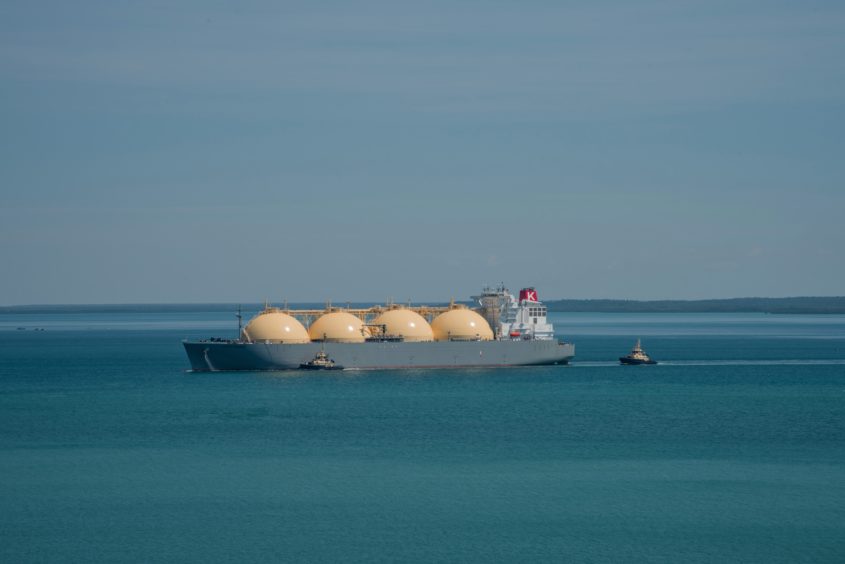
Santos has approved final investment for its $3.6 billion Barossa gas and condensate project off Australia’s Northern Territory that is targeting production in 2025. The go-ahead marks the biggest investment in Australia’s oil and gas sector since 2012.
The Barossa development will supply replacement gas for the 3.7 million tonnes per year Darwin LNG (DLNG) export plant, which is currently supplied by the ageing Bayu-Undan field in the Timor Sea. The final investment decision (FID) will also kick-start $600 million worth of investment to extend the life of the Darwin LNG facility by about 20 years and connect pipelines to the gas field, which lies about 300kms off the coast of Australia.
Santos said in a statement today that Barossa is one of the lowest cost, new LNG supply projects in the world, that will give Darwin LNG a competitive advantage in a tightening global LNG market.
“Barossa is an economically attractive backfill investment because it can utilise the existing DLNG infrastructure. As a result, it can compete with greenfield global projects that need to construct expensive new LNG infrastructure,” said energy research company Wood Mackenzie.
RBC Capital Markets noted that the Barossa project is targeting a cash cost of production of about $2 per million British thermal units (Mmbtu), making it the lowest cost new source of LNG supply in the Australian region at about $5.50/Mmbtu.
A chart shown at the company’s investor day late last year suggested, without naming competing projects, that Barossa-to-Darwin LNG would be slightly lower cost than PNG LNG and significantly below Woodside Petroleum’s brownfield projects in Western Australia, Australian research and consultancy firm EnergyQuest reported last December.
“Less than a year since we completed the acquisition of ConocoPhillips’ northern Australia and Timor-Leste assets and despite the global economic impact of a once-in-a-hundred-year pandemic, it is a great achievement to have extended the life of Bayu-Undan following the approval of the infill drilling program and now to have taken FID on the Barossa project. I’d like to thank the Australian, Northern Territory and Timor-Leste governments, our joint venture partners and our customers for their support,” said Santos chief executive Kevin Gallagher.
“I am delighted to welcome our Barossa joint venture partner SK E&S as a partner in Bayu-Undan and Darwin LNG and appreciate their support for today’s Barossa development decision,” he added.
The Barossa development will include a floating production, storage and offloading (FPSO) vessel, to be built and managed by BW Offshore, subsea production wells, supporting subsea infrastructure and a gas export pipeline tied into the existing Bayu-Undan to Darwin LNG pipeline. First gas production is targeted for the first half of 2025.
At the end of last year, Santos announced that tolling arrangements had been finalised for Barossa gas to be processed through Darwin LNG and that Santos had signed a long-term LNG sales agreement with Diamond Gas International, a wholly-owned subsidiary of Japan’s Mitsubishi Corporation, for 1.5 million tonnes of Santos-equity LNG for 10 years with extension options.
Santos has also signed memoranda of understanding with South Korea’s SK E&S and Mitsubishi to jointly investigate opportunities for carbon-neutral LNG from Barossa, including collaboration relating to Santos’ Moomba CCS project, bilateral agreements for carbon credits and potential future development of zero-emissions hydrogen.
“We will continue to explore the potential for carbon-neutral LNG from Barossa as part of our commitment to lower global emissions and as a company, reach our net-zero emissions target by 2040,” said Gallagher.
The final approval also triggers Santos’s previously agreed sale of a 25% share in Darwin LNG and in the Bayu-Undan gas field, the LNG plant’s existing source of supply, to SK E&S. That deal is expected to result in net proceeds for Santos of about $200 million.
Santos said it is continuing to negotiate a binding deal for Japan’s JERA to acquire 12.5% stake of Barossa, which would reduce its share in the field to 50%.
“Barossa and Darwin LNG life extension will create 600 jobs throughout the construction phase and secure 350 jobs for the next 20 years of production at the Darwin LNG facility,” said Santos.
